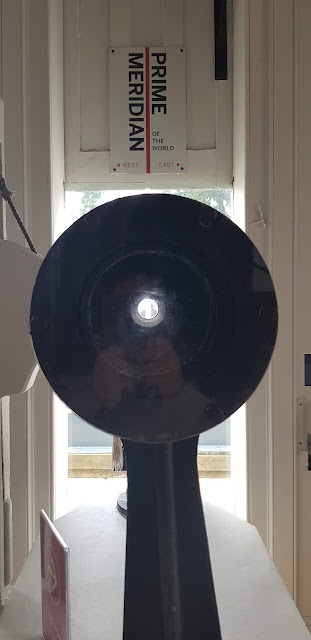 |
| The Royal Observatory, Greenwich. |
Saturday, June 26, 2021.
There is a line in the 1982 film 'Who Dares Wins' where a character states that
This line has stuck with me through the years, but, although completely accurate at the time, it is no longer the case.
We decided to take a trip to London, as a family, and visit Greenwich Market, the Park and the Royal Observatory. We would then stay a t a hotel, near The Monument, so we could spend Sunday in The Unfinished City, too.
Our first stop was the Market, where we perused the stalls before deciding what each of us wanted for lunch. Street food was the order of the day. Emma opted for sushi, while Keilyn went for a hot dog and chips. Erin had some noodles, while I chose noodles with spiced beef.
 |
| Noodle van. |
Suitably fed we made our way up towards Greenwich Park, passing the Maritime Museum and headed up the sloping hill to the Royal Observatory.
Now, I have visited the Old Royal Naval College and Greenwich Market before, but I had never ventured into the Park, much less to the top of the park.
Wandering ahead with Keilyn beneath the tree-lined avenue, which offered welcome protection from the sun, Emma and Erin took a more leisurely pace. Reaching some benches, Keilyn and I waited patiently for them to catch up, before we headed up the slope to the Observatory and the viewing area. And what a view. I had seen photographs taken by others, but I had no idea how grand the vista that now greeted us would be. I was spellbound.
 |
| The view from the top of Greenwich Park. |
We stopped for a well-deserved rest, before making our way to the entrance of the Observatory, with tickets ready.
Walking through the entrance hall and out into a small garden, the first object we discovered was William Herschel's Telescope.
 |
| William Herschel's Telescope. |
This is all that remains of the telescope which was originally a forty foot long reflecting telescope. It was, at the time, the largest telescope in the world, appearing on Ordnance Survey Maps. It was paid for King George III, at a cost of £4000, and was completed in 1789. William Herschel had discovered Uranus in 1781.
 |
| An orrery. |
 |
| A Clockwork Universe. |
 |
| Three Tompion Clocks flank the doorway. |
 |
| Morrissey Girls on the Prime Meridian. |
We then headed in to the Observatory proper, where we delighted in seeing the various telescopes and paraphernalia that had been used to make shipping and world travel easier and safer.
 |
| Prime Meridian of the world. |
 |
| Telescope and chair. |
 |
| Herschel's Telescope and view from the Royal Observatory. |
 |
| The roof of the Royal Observatory. |
 |
| Telescope at the Royal Observatory, Greenwich. |
We then made our way out, via the gift shop, and off for a drink and sit down, before heading off for a wander through Greenwich Park.

Nice Blog. Like the photos and history. On the list of places to (re)visit.
ReplyDeleteIt definitely is. I had never visited it before, so it was good to go. But, then again, any chance to go to Greenwich I will take.
ReplyDelete